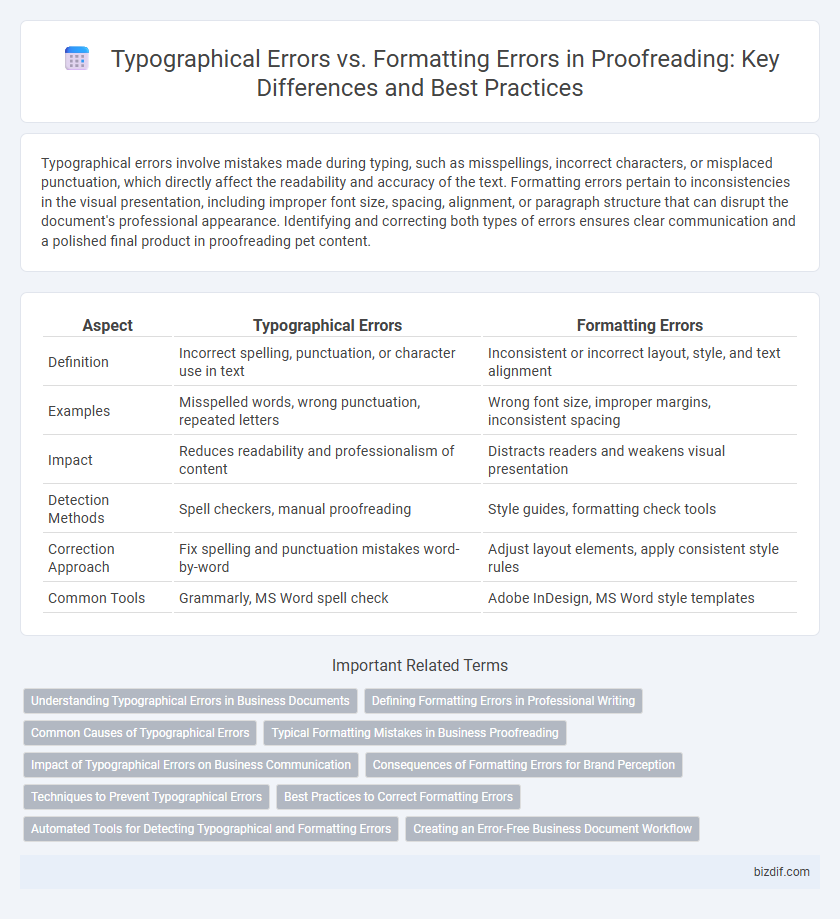Typographical errors involve mistakes made during typing, such as misspellings, incorrect characters, or misplaced punctuation, which directly affect the readability and accuracy of the text. Formatting errors pertain to inconsistencies in the visual presentation, including improper font size, spacing, alignment, or paragraph structure that can disrupt the document's professional appearance. Identifying and correcting both types of errors ensures clear communication and a polished final product in proofreading pet content.
Table of Comparison
| Aspect | Typographical Errors | Formatting Errors |
|---|---|---|
| Definition | Incorrect spelling, punctuation, or character use in text | Inconsistent or incorrect layout, style, and text alignment |
| Examples | Misspelled words, wrong punctuation, repeated letters | Wrong font size, improper margins, inconsistent spacing |
| Impact | Reduces readability and professionalism of content | Distracts readers and weakens visual presentation |
| Detection Methods | Spell checkers, manual proofreading | Style guides, formatting check tools |
| Correction Approach | Fix spelling and punctuation mistakes word-by-word | Adjust layout elements, apply consistent style rules |
| Common Tools | Grammarly, MS Word spell check | Adobe InDesign, MS Word style templates |
Understanding Typographical Errors in Business Documents
Typographical errors in business documents refer to mistakes made during text entry, such as misspellings, incorrect punctuation, or misplaced characters, which can undermine professional credibility and clarity. These errors differ from formatting errors, which involve incorrect layout or style inconsistencies like improper fonts or spacing issues. Identifying and correcting typographical errors is crucial for ensuring clear communication and maintaining the document's accuracy and professionalism.
Defining Formatting Errors in Professional Writing
Formatting errors in professional writing refer to inconsistencies or mistakes in the document's visual presentation, such as incorrect font sizes, improper alignment, inconsistent spacing, and inappropriate use of headings or bullet points. These errors disrupt the overall readability and professionalism of the text, impacting the reader's ability to navigate and understand the content effectively. Consistently applied formatting ensures clarity, enhances user experience, and supports the communication goals of the written material.
Common Causes of Typographical Errors
Typographical errors typically arise from mistyping letters, hitting adjacent keys, or accidental omissions due to fast typing and lack of proofreading. Common causes include cognitive slips such as letter transposition, fatigue leading to decreased attention, and unclear source material that confuses the typist. Unlike formatting errors, which involve layout issues, typographical errors mainly concern incorrect characters within the text itself.
Typical Formatting Mistakes in Business Proofreading
Typical formatting mistakes in business proofreading include inconsistent font styles, improper alignment of text, and incorrect line spacing. These errors disrupt the document's professional appearance and can confuse readers or weaken the intended message. Ensuring uniform margins, consistent headings, and proper use of bullet points enhances clarity and presentation.
Impact of Typographical Errors on Business Communication
Typographical errors in business communication can significantly damage a company's credibility, leading to misunderstandings and loss of client trust. These errors disrupt the clarity of messages, resulting in decreased professionalism and potential financial repercussions. Ensuring accurate text through thorough proofreading minimizes risks and maintains a strong corporate image.
Consequences of Formatting Errors for Brand Perception
Formatting errors can significantly damage brand perception by creating an impression of unprofessionalism and carelessness, leading to decreased trust among customers and stakeholders. Inconsistent fonts, spacing issues, and misaligned text undermine the clarity and readability of marketing materials, resulting in reduced engagement and weakened brand credibility. High-quality formatting reinforces brand identity, ensuring communication appears polished and reliable, which is essential for maintaining customer loyalty and competitive advantage.
Techniques to Prevent Typographical Errors
Employing spell check tools and utilizing grammar software significantly reduce typographical errors by automatically identifying misspelled words and incorrect syntax. Manual proofreading techniques such as reading text aloud and reviewing content multiple times at different intervals help catch errors that automated tools may overlook. Implementing a standardized style guide and maintaining consistent formatting during the drafting process also minimize the occurrence of typographical mistakes.
Best Practices to Correct Formatting Errors
Correcting formatting errors requires a systematic approach, starting with consistent use of styles and templates to maintain uniformity in fonts, headings, and spacing throughout the document. Utilizing software tools like style guides in Microsoft Word or Google Docs helps automate detection and correction of misaligned margins, inconsistent indentation, and improper paragraph spacing. Final proofreading stages should include manual checks for orphaned lines, widows, and inconsistent line breaks to ensure professional presentation and readability.
Automated Tools for Detecting Typographical and Formatting Errors
Automated tools for detecting typographical and formatting errors leverage AI algorithms to identify misspellings, punctuation mistakes, inconsistent fonts, and misaligned text. Advanced software like Grammarly and PerfectIt integrates natural language processing and pattern recognition to enhance accuracy in proofreading by distinguishing between typographical slips and formatting inconsistencies. These tools reduce manual proofreading time while improving document quality through real-time error detection and automated corrections.
Creating an Error-Free Business Document Workflow
Typographical errors, such as misspellings and incorrect punctuation, directly impact the readability and professionalism of business documents, while formatting errors affect the visual consistency and overall presentation. Implementing a structured proofreading workflow that includes automated spell-check tools, style guides, and multiple review stages minimizes both typographical and formatting errors. This approach ensures error-free business documents, enhancing credibility and effective communication.
Typographical Errors vs Formatting Errors Infographic

 bizdif.com
bizdif.com